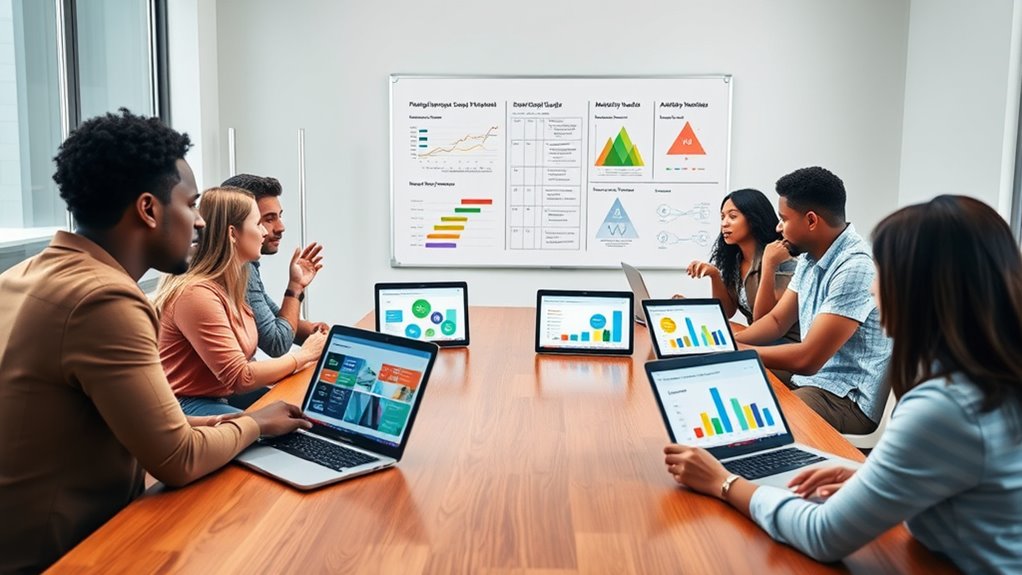Meeting maturity models help you evaluate how well your team collaborates during meetings. They guide you to identify communication barriers, such as unclear agendas or dominating voices, and track progress over time. By analyzing your current practices, you can address gaps, improve engagement, and build trust through structured agendas and feedback loops. Using technology and leadership support, you create a culture of open, effective collaboration. Keep exploring to learn how to implement these strategies successfully.
Key Takeaways
- Use frameworks to evaluate meeting practices, focusing on communication clarity, participation, and agenda effectiveness.
- Assess team stages from unstructured to structured meetings, emphasizing trust, shared ownership, and consistent routines.
- Monitor collaboration metrics like engagement, problem-solving, and meeting frequency to identify gaps and track progress.
- Gather participant feedback and conduct regular reviews to foster continuous improvement and a culture of open communication.
- Leverage technology and remote facilitation tools to enhance engagement, address cross-cultural barriers, and support structured meetings.
Understanding Meeting Maturity Models
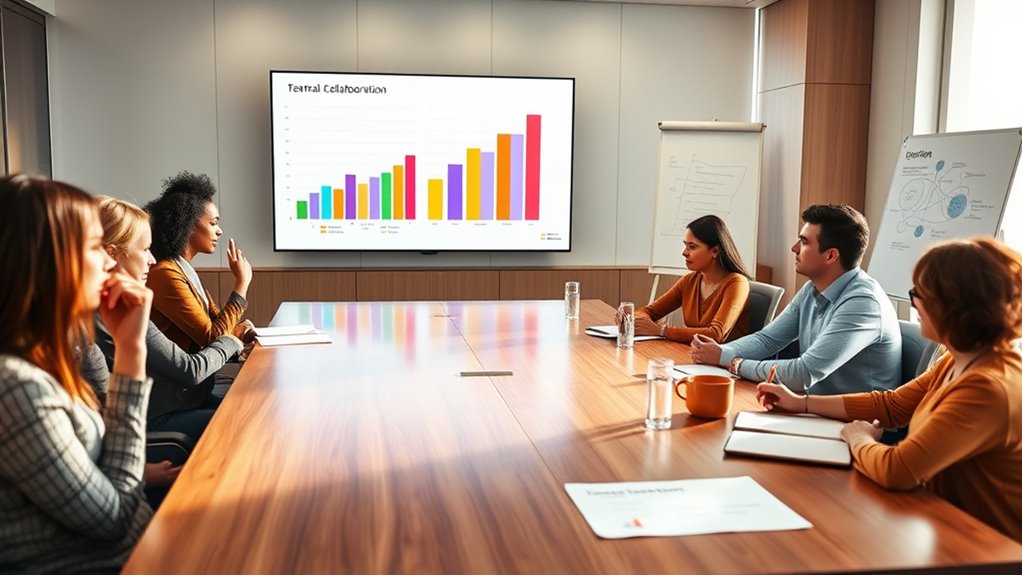
Understanding Meeting Maturity Models helps organizations evaluate and improve their meeting practices systematically. These models provide a framework to assess your meeting dynamics, highlighting how effectively your team communicates and collaborates. By examining your current practices, you’ll identify communication barriers that hinder productivity, such as unclear agendas or dominating voices. Recognizing these challenges allows you to implement targeted improvements, fostering more open and efficient discussions. Meeting maturity models also help you understand how your team evolves over time, moving from unstructured sessions to highly coordinated and purposeful meetings. This understanding enables you to develop strategies that promote better engagement, clarity, and alignment, ultimately enhancing overall team performance and decision-making.
The Stages of Collaboration Development
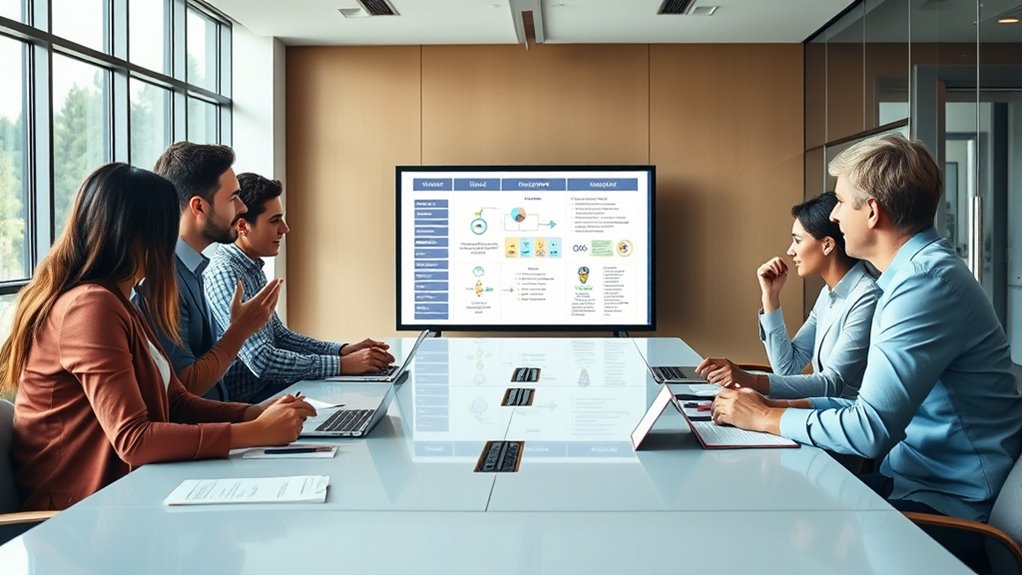
As your team progresses, you’ll notice changes from basic interactions to more structured cooperation. Early on, initial team dynamics set the foundation for trust and communication. Eventually, advanced collaboration strategies help your team work more efficiently and innovate together. Incorporating effective tools and techniques can further enhance your team’s collaborative capabilities.
Initial Team Dynamics
In the initial stages of team development, members often focus on establishing trust, clarifying roles, and figuring out how to work together effectively. At this point, team cohesion is still forming, and members may hesitate to share ideas openly. Building trust helps create a safe environment where everyone feels valued. Conflict resolution is also critical during this phase; small disagreements can hinder progress if not addressed promptly. Your goal is to encourage open communication and foster mutual understanding. As you work through these early dynamics, you’ll notice how trust and clarity lay the foundation for smoother collaboration later on. Understanding trust-building strategies is essential to fostering a cohesive team environment. Remember, patience and active listening are key to helping your team develop a strong, cohesive dynamic that supports ongoing growth.
Advanced Collaboration Strategies
How do teams shift from basic cooperation to seamless, high-level collaboration? The key is mastering advanced collaboration strategies. You’ll want to incorporate remote facilitation techniques that keep everyone engaged, regardless of location. Use virtual engagement tools to foster active participation and create a sense of connection. As your team progresses, focus on facilitating open communication, encouraging diverse input, and building trust across all members. Incorporate structured activities that promote shared ownership and accountability, making collaboration more natural. Consistently refine your approach by seeking feedback and adjusting your methods. These strategies help move your team beyond surface-level cooperation, enabling high-performing, cohesive collaboration—no matter where your team members are working from. Additionally, understanding the support hours of various entertainment venues can help coordinate team activities or breaks during working hours.
Assessing Your Team’s Current Meeting Practices
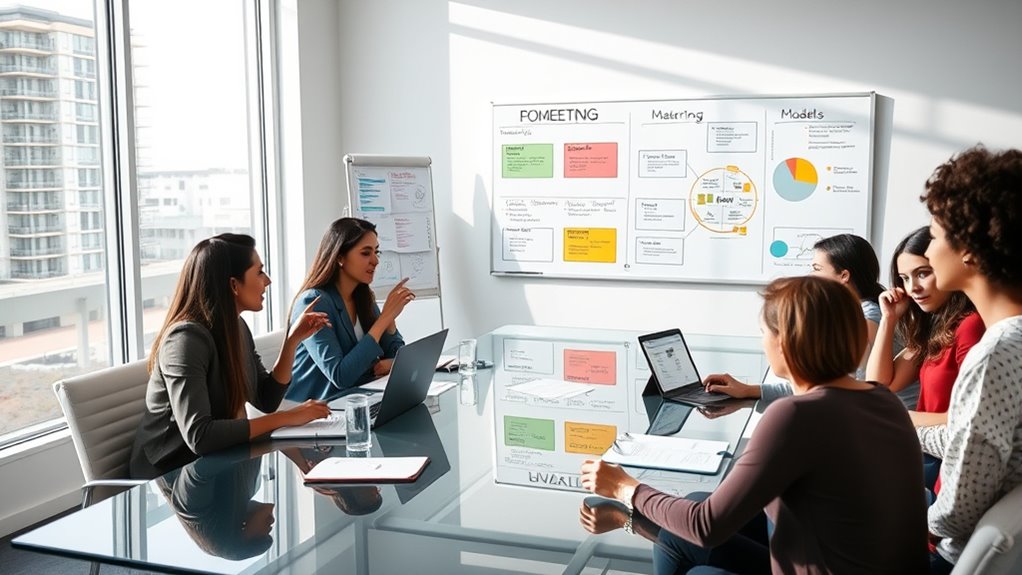
Start by reviewing how often and how long your meetings typically last to identify any inefficiencies. Observe how engaged your team members are and whether everyone participates actively. This assessment will help you understand where your current practices excel or need improvement. Additionally, consider analyzing how effectively your team utilizes meeting time by implementing meeting best practices to optimize collaboration.
Meeting Frequency and Duration
Have you ever considered whether your team’s meeting schedule truly supports productivity? The frequency and duration of your meetings directly impact how well your team stays aligned and engaged. Too many meetings can cause fatigue, especially for remote attendees who might face constant distractions. Conversely, infrequent meetings can lead to miscommunication and missed opportunities. Evaluate whether your meetings are appropriately spaced to maintain steady meeting pacing—balancing enough touchpoints without overwhelming your team. Short, focused meetings often boost participation and clarity, while lengthy sessions risk diminishing attention. Regularly review your schedule to ensure meetings are necessary, effective, and timed to support collaboration without hindering individual productivity. Adjusting frequency and length can considerably improve your team’s overall meeting effectiveness. Additionally, aligning your meeting practices with discovery and personality models can help tailor sessions to better fit your team’s unique dynamics.
Engagement and Participation Levels
Evaluating the level of engagement and participation in your team’s meetings provides valuable insights into their effectiveness. When team members actively contribute, it boosts team motivation and fosters a sense of ownership. Observe whether participants follow meeting etiquette, such as listening attentively and refraining from distractions. Are everyone’s voices heard, or do a few dominate the conversation? Low participation may indicate disengagement or unclear expectations. Encouraging open dialogue, setting clear ground rules, and inviting quieter members to share can improve involvement. Recognizing contributions and maintaining respectful communication help cultivate an environment where team members feel valued and motivated to participate. Regularly assessing these behaviors allows you to identify areas for improvement and create more inclusive, productive meetings. Paying attention to engagement levels can also reveal underlying issues, such as unclear roles or insufficient motivation, that might be impacting collaboration.
Identifying Common Collaboration Gaps
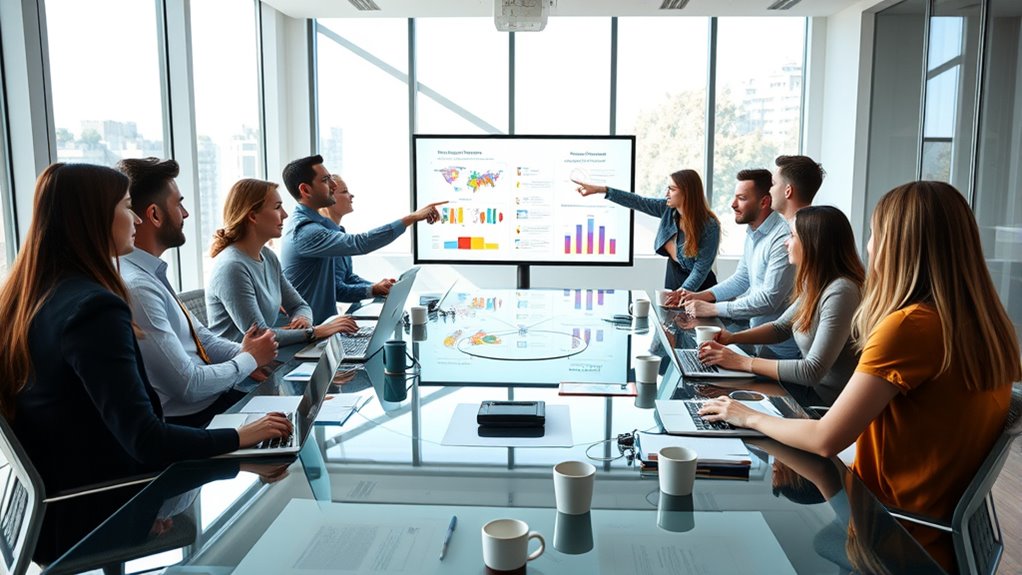
How can organizations pinpoint the most common collaboration gaps that hinder their progress? Start by observing how conflicts arise and are resolved within your team. Frequent unresolved conflicts often reveal issues with communication or trust. Leadership involvement is key—if managers aren’t actively addressing these conflicts, problems can fester and impair collaboration. Assess whether team members feel comfortable sharing ideas or raising concerns. Lack of open communication indicates gaps in psychological safety. Additionally, review how decisions are made and conflicts are managed. Are leaders facilitating effective conflict resolution, or are issues left unaddressed? Recognizing these patterns helps you identify where collaboration is breaking down, so you can target specific gaps—be it communication breakdowns, leadership blind spots, or unresolved conflicts—ultimately strengthening your team’s cohesion. The role of conflict resolution techniques can be instrumental in bridging these gaps and fostering a more collaborative environment.
Tools and Techniques for Diagnosis
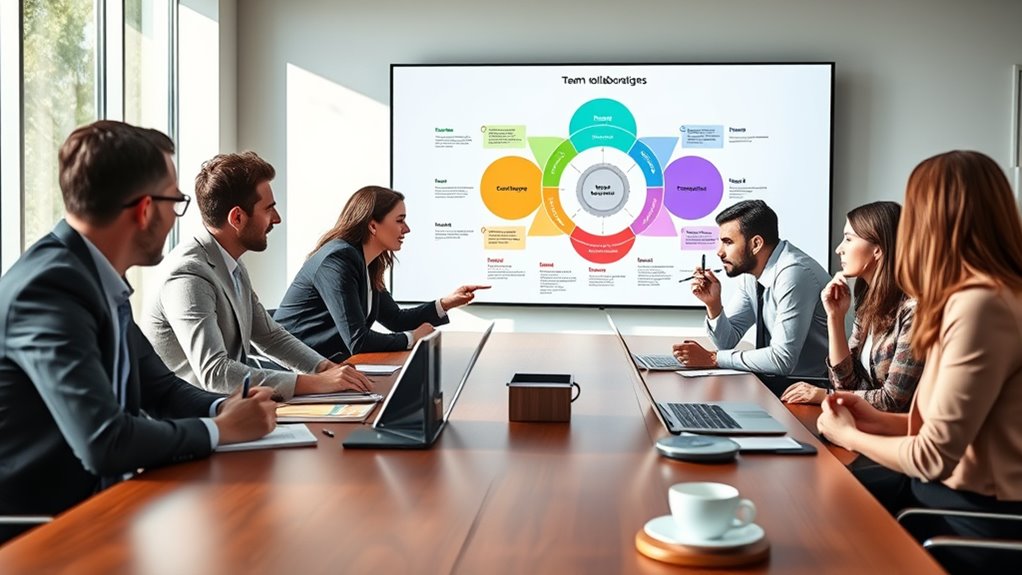
To effectively diagnose collaboration gaps, organizations need to leverage targeted tools and techniques that reveal underlying issues. Virtual facilitation is a powerful method, helping you observe how teams engage during remote meetings and identify communication breakdowns. Using structured surveys and feedback tools can uncover gaps in cross-cultural communication, highlighting misunderstandings or differing expectations. Observation checklists during virtual sessions allow you to assess participation levels and collaboration dynamics in real-time. Additionally, conducting cultural awareness assessments helps pinpoint barriers caused by diverse backgrounds. Combining these techniques provides a *holistic* picture of your team’s collaboration maturity. By applying these tools, you gain actionable insights to tailor interventions, foster clearer communication, and elevate overall teamwork effectiveness.
Moving From Ad Hoc to Structured Meetings
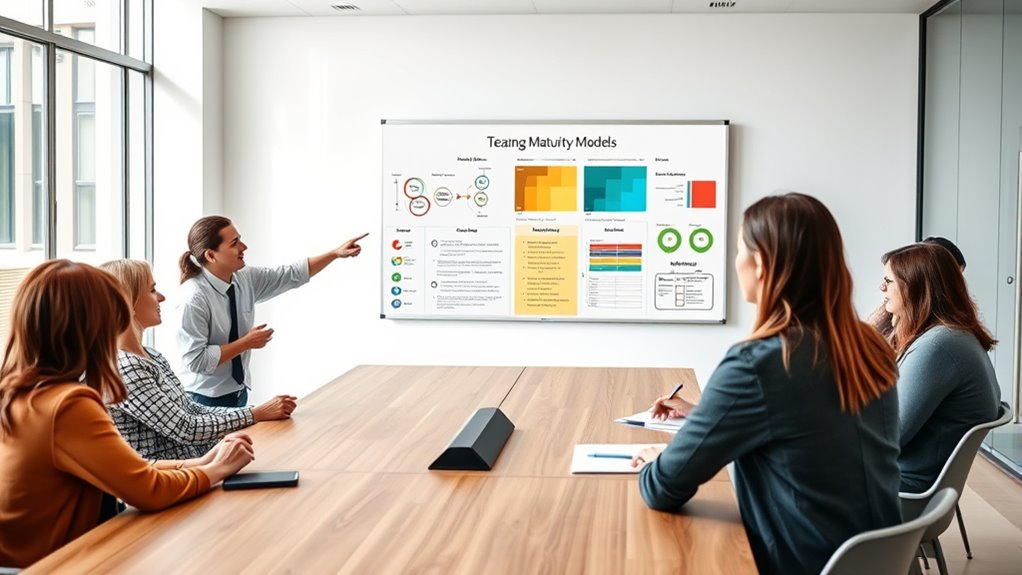
To move from ad hoc to structured meetings, you need to establish clear agendas that set expectations upfront. Consistent scheduling helps everyone plan ahead and stay committed. These steps create a foundation for more productive and focused discussions. Incorporating transparent practices into your process ensures trust and accountability within your team.
Establish Clear Agendas
Establishing clear agendas transforms meetings from unpredictable gatherings into focused, productive sessions. Effective agenda setting is vital for guiding discussions and ensuring everyone knows what to expect. When you define specific topics beforehand, it promotes clarity and helps prioritize key issues. This clarity prevents tangents and keeps the meeting on track, saving time and boosting engagement. Prioritization within your agenda ensures the most important items receive attention first, making the best use of everyone’s energy. Share the agenda in advance, so participants can prepare and contribute meaningfully. As a result, meetings become more efficient, decision-making accelerates, and team collaboration improves. Regularly assessing and adjusting your agenda can further enhance meeting productivity. Clear agendas lay the foundation for structured meetings that foster accountability and drive progress.
Implement Consistent Scheduling
Implementing consistent scheduling transforms irregular, ad hoc meetings into reliable opportunities for collaboration. Scheduling consistency guarantees your team knows when meetings happen, reducing confusion and wasted time. Establish clear routines by setting regular times and endpoints, making it easier for everyone to plan accordingly. Punctuality practices reinforce respect for others’ time and promote professionalism. When meetings occur consistently, team members can prepare in advance, contributing more effectively. Use shared calendars and reminders to maintain regularity and avoid last-minute cancellations. This structure fosters accountability and trust, encouraging active participation. Moving away from sporadic meetings to a predictable schedule enhances communication flow and teamwork. Recognizing Relationship Dynamics within the team can further improve collaboration and understanding. By prioritizing scheduling consistency, you lay the foundation for more productive, focused discussions that support your team’s growth.
Implementing Continuous Improvement Strategies

Building a culture of continuous improvement requires more than just setting goals; it demands deliberate strategies that embed ongoing evaluation and refinement into daily operations. You should actively seek meeting feedback from participants to identify areas for enhancement. Regularly reviewing this feedback helps you pinpoint what works and what needs adjustment, fostering a mindset of growth. Leadership alignment is essential—when leaders consistently support and model improvement practices, it encourages team members to do the same. Implement structured processes for reflection after meetings, encouraging open dialogue about what can be improved. By integrating feedback loops and ensuring leadership commitment, you create an environment where continuous improvement becomes part of your team’s DNA, driving better collaboration and more effective meetings over time.
Measuring Progress Over Time
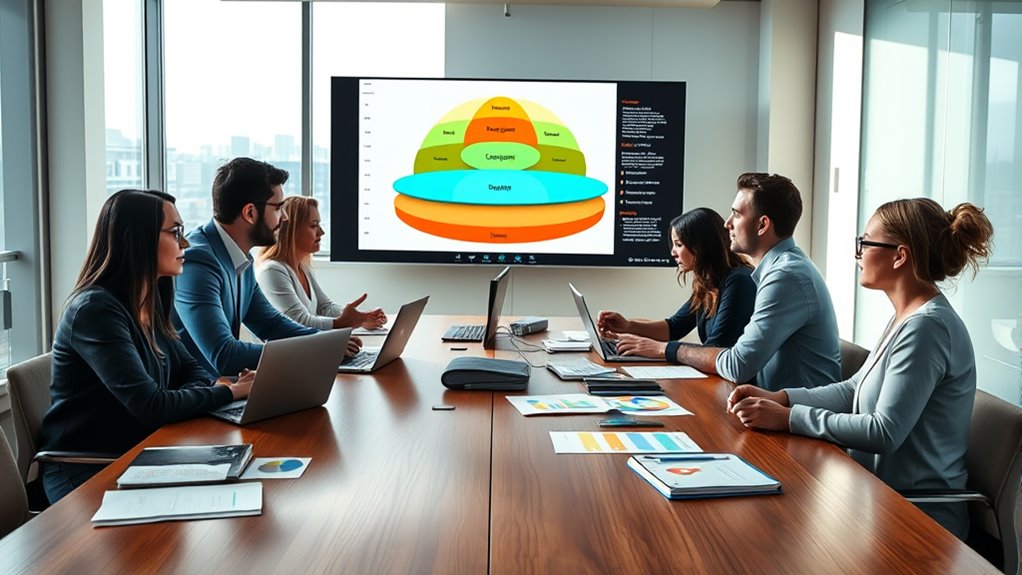
To effectively track your progress, you need to measure it consistently over time. Regular time tracking helps you identify patterns and gauge improvements in your team’s collaboration. By documenting milestones and setbacks, you create a clear record of development. This data allows you to assess whether your team is moving toward higher maturity levels. Stakeholder alignment is essential; regularly sharing progress updates ensures everyone stays informed and committed to the same goals. Use metrics that reflect collaboration quality, like communication frequency or problem-solving effectiveness. Tracking these indicators over weeks or months provides insight into trends and areas needing attention. Consistent measurement keeps your efforts focused, enabling you to adapt strategies proactively and celebrate incremental successes along the way.
Building a Culture of Effective Collaboration
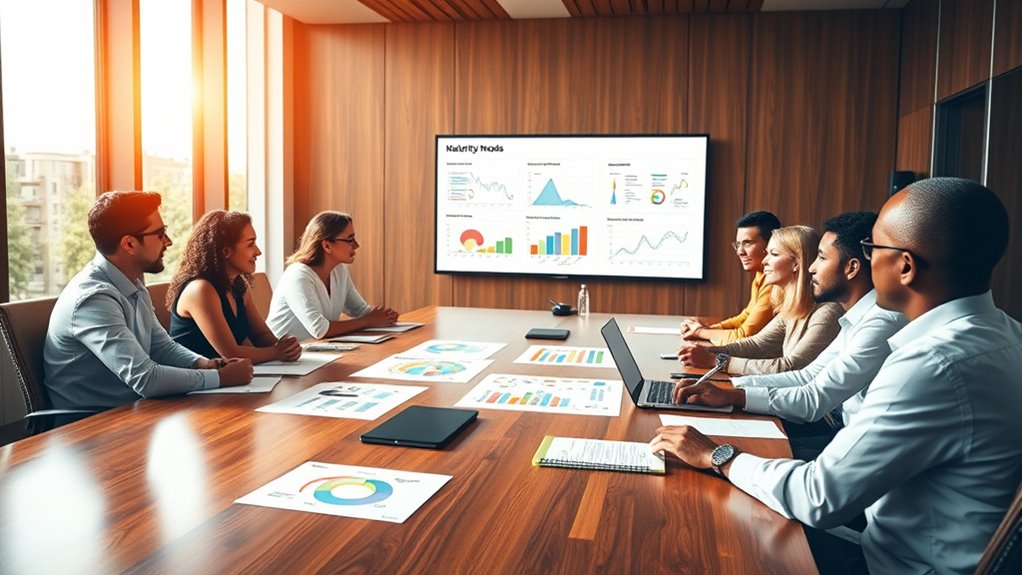
Creating a culture of effective collaboration starts with establishing shared values and expectations that encourage open communication and mutual respect. You need to prioritize team building activities that foster trust and strengthen relationships, making collaboration seamless. Leadership development plays a pivotal role—leaders must model transparency, active listening, and inclusivity to set the tone for the entire team. When leaders demonstrate commitment to these principles, it encourages team members to follow suit, creating a positive feedback loop. Consistently reinforcing shared goals and emphasizing the importance of collaboration helps embed these values into your team’s daily routines. Ultimately, a strong, collaborative culture hinges on intentional efforts to develop both your team dynamics and leadership capabilities, ensuring everyone feels valued and motivated to work together effectively.
Leveraging Technology to Enhance Meeting Maturity
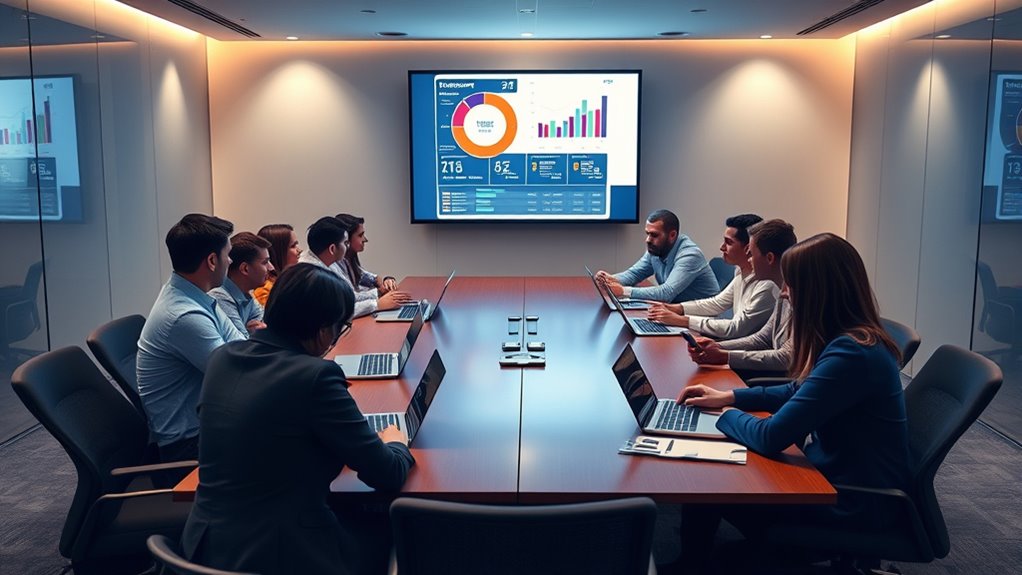
Leveraging technology can substantially advance your team’s meeting maturity by streamlining communication, increasing engagement, and ensuring accountability. Virtual breakout rooms enable focused discussions, allowing team members to collaborate more effectively in smaller groups before sharing insights with the larger team. AI summarization tools help capture key points and action items automatically, saving time and reducing misunderstandings. These technologies make meetings more dynamic and productive, encouraging participation from all members. By integrating virtual breakout sessions, you foster deeper engagement, while AI summaries keep everyone aligned and informed. Together, these tools create a more mature meeting environment where collaboration is seamless, participation is meaningful, and follow-up is clear. Embracing such technology transforms your meetings into powerful drivers of team success.
Frequently Asked Questions
How Often Should Teams Reassess Their Meeting Maturity Levels?
You should regularly evaluate your team’s meeting effectiveness by considering appropriate meeting frequency and reassessment strategies. Reassessing every few months helps identify areas for improvement and keeps collaboration aligned with goals. Adjust your meeting schedules based on team feedback and project needs. Implement reassessment strategies like surveys or retrospectives to gather insights. This ongoing process guarantees your team stays productive, engaged, and continuously improves its meeting practices.
Can a Team Skip Certain Maturity Stages?
Like skipping stones across a pond, your team might wonder if you can leap over maturity stages. While it’s tempting to bypass some phases, meeting flexibility and leadership influence are crucial for smooth sailing. Skipping stages risks missing essential skills and trust-building. To grow stronger, embrace each stage’s lessons, guiding your team with intentional leadership. This steady approach ensures your team’s collaboration blossoms naturally, avoiding cracks in the foundation.
What Are Common Barriers to Advancing Meeting Maturity?
You might face barriers like resistance to change or inconsistent processes when trying to advance meeting maturity. Technology integration can be a hurdle if your tools aren’t user-friendly or well-adopted. Leadership influence plays a key role—without strong support and clear direction, teams struggle to progress. Overcoming these barriers requires fostering a culture open to change, providing proper training, and ensuring leadership actively promotes effective meeting practices.
How Do Team Dynamics Influence Meeting Maturity Development?
Team dynamics greatly influence meeting maturity development by shaping team communication and how effectively you use meeting technology. When your team fosters open dialogue and mutual trust, meetings become more productive and collaborative. Conversely, poor communication and resistance to new meeting tools can hinder progress. By actively improving team interactions and embracing meeting technology, you create an environment where meetings evolve to higher maturity levels, boosting overall team performance.
Is There a Standard Timeline for Progressing Through Maturity Stages?
There isn’t a standard timeline for progressing through meeting maturity stages because each team’s development varies. You can track your progress with meeting metrics and collaboration benchmarks, which help identify where your team stands and what improvements are needed. Regularly reviewing these indicators allows you to adapt your approach and accelerate growth, ensuring your team moves efficiently through maturity levels based on real performance rather than fixed timeframes.
Conclusion
Think of your team’s collaboration as a garden—you’re the gardener tending to its growth. By understanding your current meeting maturity, addressing gaps, and nurturing with the right tools, you cultivate a vibrant, productive environment. Keep evaluating, adjusting, and fostering a culture of openness. With consistent care, your team will blossom into a flourishing landscape of seamless collaboration, where ideas grow freely and success blooms naturally.
